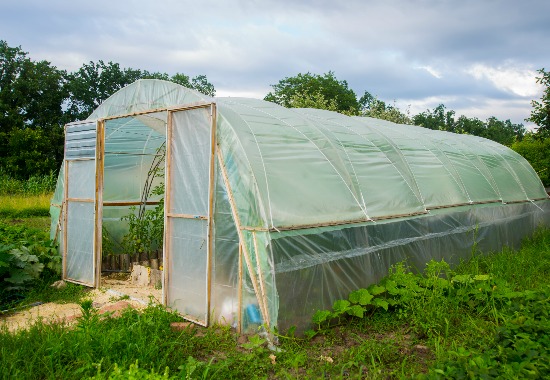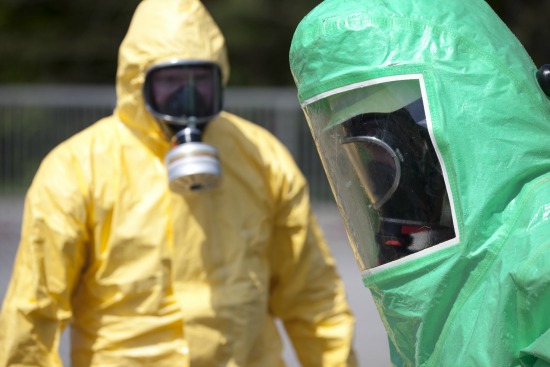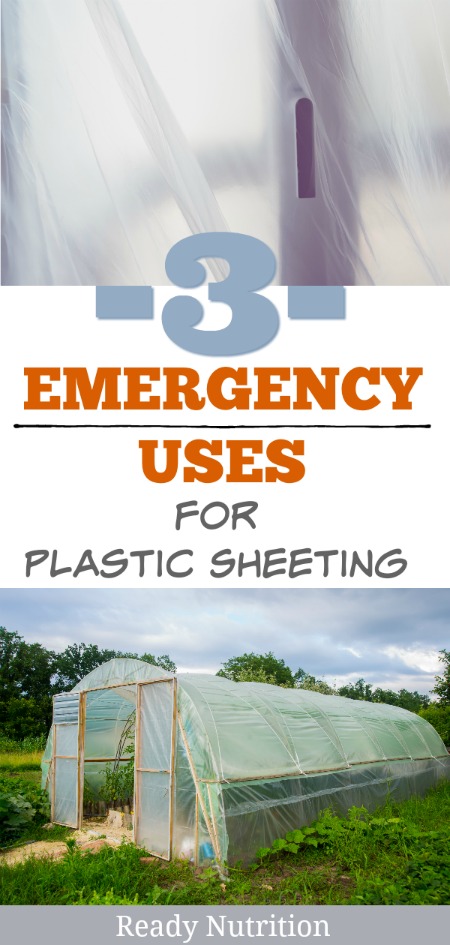The focus in this article is on rolls of plastic sheeting, and why you need it in your emergency supplies. Plastic sheeting is a cheap and multipurpose prep that has many uses in a survival situation. It can be used for rainwater collection, making a solar still, waterproofing containers, and it can even be used in a worst-case scenario as a body bag.
The best type of sheeting to store is 6 to 8-mil thickness. This can provide you with a wide range of emergency uses. I found a good type for you, made by Frost King, labeled as “Crystal Clear Vinyl Sheeting” for those windows. I have a roll of 3’ x 75’ for use with most of my windows if I lose them. It is also “greenhouse-grade” plastic, although it doesn’t have a UV rating. The best feature? It is 8 mil in thickness: that’s good stuff. It is also transparent, not translucent, so you can actually see through it.
3 Ways You Can Make Plastic Sheeting Work in an Emergency!
1. Make a Greenhouse

Learn how to make a plastic sheeting greenhouse for $50
How to add plastic sheeting to a greenhouse – the easy way
2. Temporary Repair From Natural Disasters

Wind and snow are conditions that tend to bring down trees, especially in the Rockies, as pine trees are not deeply rooted in the way deciduous trees are. The loss of a window in wintertime isn’t an inconvenience here: it’s an emergency of the highest order, especially when it’s 10 or 15 degrees below zero. If it happens, you need to close up the window and fast.
For hurricane and storm-susceptible areas, I’ve already covered how important it is to have pre-measured pieces of pressure-treated plywood cut for each window. I also mentioned how it would behoove you to pre-drill holes in both the corners of that plywood and in the exterior casing of the window frames (if applicable) where you will mount the plywood with galvanized deck bolts. First, seal it up with plastic sheeting on the outside, and then cover it up with the sheet of pre-cut plywood.
High winds may rip your sheathing off, but if you pick up some fir strips or 1” x 3” strips, you can cut them to be able to outline your window frames. After tacking the plastic up with the staples, then put the fir strips up all along the outer edges of the plastic. Use a cordless drill and put deck screws in (2-inchers will do just fine) to secure the fir strips. They will act as a “frame” to support the outer edges of the plastic and to hold it down, thus preventing the wind from ripping it off of your now-broken window.
Don’t forget to put on heavy gloves and remove the glass from the windows all around. If the wind blows, you don’t want the sheet of plastic to flap against the window aperture and be ripped by shards of glass, not to mention the safety issue for those inside. My recommendation is to cover the inside as well as the outside. The reason you don’t want to cover just the inside is that there is nothing to really seal the window off when the wind blows, and the sheet is moved inward, causing more problems if it knocks things over or is dislodged.
Again, if you’re in a storm-susceptible area, you may even want to go so far as to have extra windows protected and in storage for replacement when such work can be undertaken. It also doesn’t stop there. You may even need that sheeting to temporarily close off a roof with a hole from a falling tree or flying debris. You can use it to protect something that is exposed with lack of a tarp.
You also want to pick up a good staplegun with long staples, such as ½ inch. Cheap you buy, and cheap you shall receive: stick with Stanley, and you can order one along with the staples on www.amazon.com as well. Keep in mind: this is your temporary fix…one that may need to be in place for a month to two months. Without windows, your “R” factor and insulation are going to diminish quickly. The staples can be put in on the edges quickly, and then emplaced for long-term with fir strips.
3. Pandemic Containment

It is important for you to pick up a few rolls for your home that can benefit you and your family not just for use in a greenhouse, but in a disaster, as well. Stock up on a few rolls of it, and you’ll appreciate your own efforts when something occurs. Just one time and it pays for itself. JJ out!

This article was originally published at Ready Nutrition™ on July 18th, 2018







Yes, I LOVE the plastic sheeting, but be aware that pretty much ALL the cheap stuff is made to break down in just a few months of exposure to UV rays (sunlight), especially in the hot summer. This stuff may actually survive an entire winter if you put it up LATE in the season.
For outdoor use, it would be better to have some rolls of the BLACK plastic, (but it makes for a REALLY hot shelter). Greenhouse rated, or UV resistant plastic will make much better shelters, AND, if you REALLY want some LONG LIFE plastic for shelter or Greenhouse, then get the CLEAR plastic, SWIMMING POOL COVER (Bubble Wrap), it is available up to 16 Mils !!!
It holds heat MUCH better than single ply plastic, and is SO durable, the better stuff comes with a 7 year warranty !!!
I bought a roll of 16ft X 32ft, 16 mils, for less than $150. When installed as a greenhouse, you can throw a standard size BRICK at it with FULL force and the brick will just BOUNCE OFF !!!
Then you can throw a CEMENT BLOCK at it, and still just BOUNCE OFF.
The stuff is SO strong, I think it would even resist having somebody toss a RAIL ROAD TIE at it.
I use rolls of the cheap, BLACK plastic to lay on the ground, to KILL all the vegetation, to get the area ready to be used for garden space! Yes, I use a shovel to dig and put some dirt all around the outer edges to keep the wind from lifting and blowing it away. After a couple of weeks, the area is sterile. I’d suggest, watering the dirt BEFORE you put down the black plastic so all the hidden weed SEEDS will sprout and DIE.
This will save your future garden from being overrun by weeds.